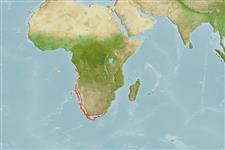Elasmobranchi (squali e razze) (sharks and rays) >
Rajiformes (Skates and rays) >
Arhynchobatidae (Softnose skates)
Etymology: Bathyraja: Greek, bathys = deep + Latin, raja, -ae = a ray (Raja sp) (Ref. 45335).
More on authors: Müller & Henle.
Environment: milieu / climate zone / depth range / distribution range
Ecologia
marino batidemersale; distribuzione batimetrica 440 - 1020 m (Ref. 5578). Deep-water; - 40°S
Southeast Atlantic: off central Namibia to Agulhas Bank, South Africa.
Size / Peso / Age
Maturity: Lm ? range ? - ? cm
Max length : 120 cm TL maschio/sesso non determinato; (Ref. 5578)
Short description
Morfologia | Morfometria
A large softnose skate with a broadly triangular, bluntly pointed snout and an angular pectoral disc; tail shorter than body and with a single row of large thorns; upper disc of young with thorns but these are lost with growth (Ref. 5578). Dorsal surface greyish and may have white spots, ventral surface white with dark grey blotches around gill slits, vent and along ventral surface of tail (Ref. 5578). Tail with no color bands (Ref. 5578).
Found on the upper continental slope (Ref. 27121). A bottom-predator that feeds on bony fishes including hake, jacopever, barracudina and dragonet; also squid, octopus, crabs and prawns (Ref. 5578). Oviparous (Ref. 50449). Eggs have horn-like projections on the shell (Ref. 205). Sometimes caught by hake trawlers (Ref. 5578).
Life cycle and mating behavior
Maturità | Riproduzione | Deposizione | Uova | Fecundity | Larve
Oviparous, paired eggs are laid. Embryos feed solely on yolk (Ref. 50449). Eggs have horn-like projections on the shell (Ref. 205).
McEachran, J.D. and K.A. Dunn, 1998. Phylogenetic analysis of skates, a morphologically conservative clade of elasmobranchs (Chondrichthyes: Rajidae). Copeia 1998(2):271-290. (Ref. 27314)
IUCN Red List Status (Ref. 130435)
Threat to humans
Harmless
Human uses
Informazioni ulteriori
Age/SizeAccrescimentoLength-weightLength-lengthLength-frequenciesMorfometriaMorfologiaLarveDinamica popolazioni larvaliReclutamentoAbbondanzaBRUVS
BibliografiaAcquacolturaProfilo di acquacolturaVarietàGeneticaElectrophoresesEreditarietàMalattieElaborazioneNutrientsMass conversion
Strumenti
Special reports
Download XML
Fonti Internet
Estimates based on models
Preferred temperature (Ref.
123201): 4.6 - 11.8, mean 5.4 °C (based on 13 cells).
Phylogenetic diversity index (Ref.
82804): PD
50 = 0.5000 [Uniqueness, from 0.5 = low to 2.0 = high].
Bayesian length-weight: a=0.00513 (0.00253 - 0.01042), b=3.12 (2.95 - 3.29), in cm total length, based on LWR estimates for this Genus-body shape (Ref.
93245).
Trophic level (Ref.
69278): 4.3 ±0.67 se; based on food items.
Resilienza (Ref.
120179): Basso, tempo minimo di raddoppiamento della popolazione 4.5 - 14 anni (Fec assumed to be <100).
Fishing Vulnerability (Ref.
59153): High to very high vulnerability (72 of 100).
